These Pandan Butterscotch Mochi Bars are a Southeast-Asian twist on the incredible Hawaiian Butter Mochi. They are just as chewy, buttery and coconuty as the original version but with the added flavours of butterscotch and fragrant pandan. Inspired by the infamous ondeh ondeh in Singapore, these treats are honestly the stuff of dreams, and couldn’t be any simpler to make!
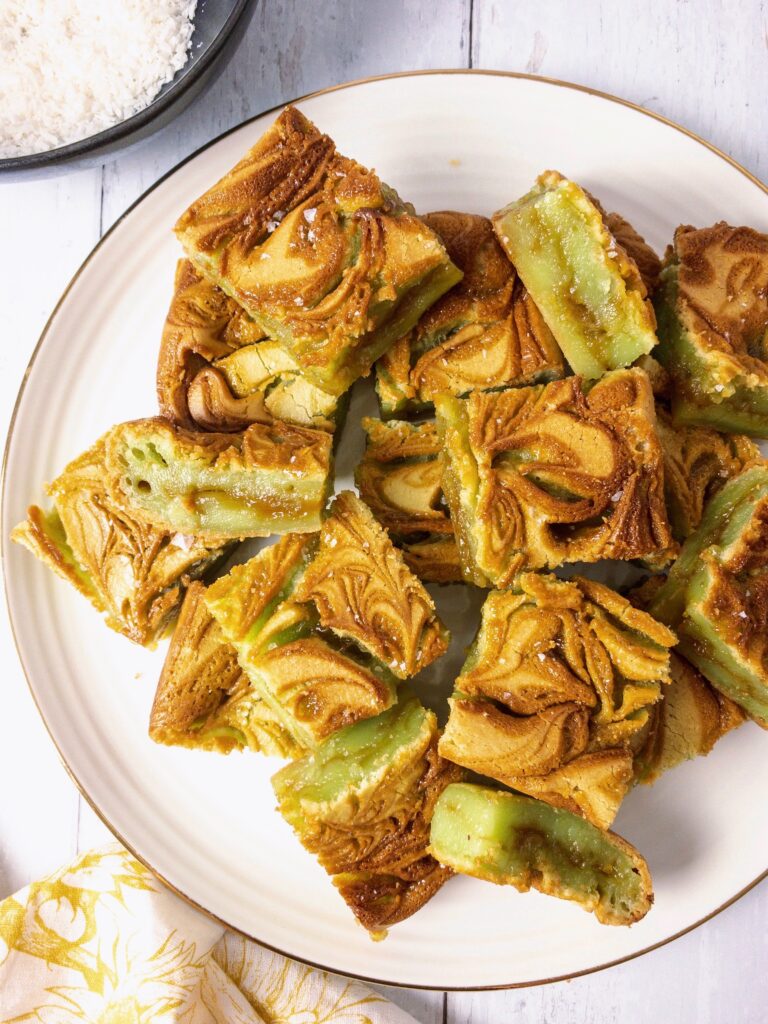
These Pandan Butterscotch Mochi Bars are something that I would gladly eat every single week. They are insanely delicious and takes literally 15 minutes of active ‘cooking’ time. Best of all, it’s inspired by one of my all-time favourite childhood snack ondeh ondeh – pandan flavoured glutinous rice balls rolled in shredded coconut and when bitten into, reveals a surprise centre of melted gula melaka (Malaysian palm sugar). I’ve therefore taken the three key elements of ondeh ondeh – coconut, pandan, and gula melaka – and incorporated them into a Hawaiian Butter Mochi.
Let me backtrack a little.
I chanced upon Hawaiian Butter Mochi a couple of months ago and I’m not even kidding when I say that my first bite was such an enlightening moment. I love mochi and the fact that Butter Mochi’s are crispy on the outside, chewy inside and well… buttery, just blew my mind. You know that moment when you just wonder “where have you been all my life”? It was like that but over and over again. That was when I started my research into Butter Mochi, trying various recipes and understanding how certain ingredients changed its texture and flavours. Countless batches in, I discovered Two Red Bowl’s Butterscotch Mochi Bars recipe and decided to add a Singaporean twist to it.
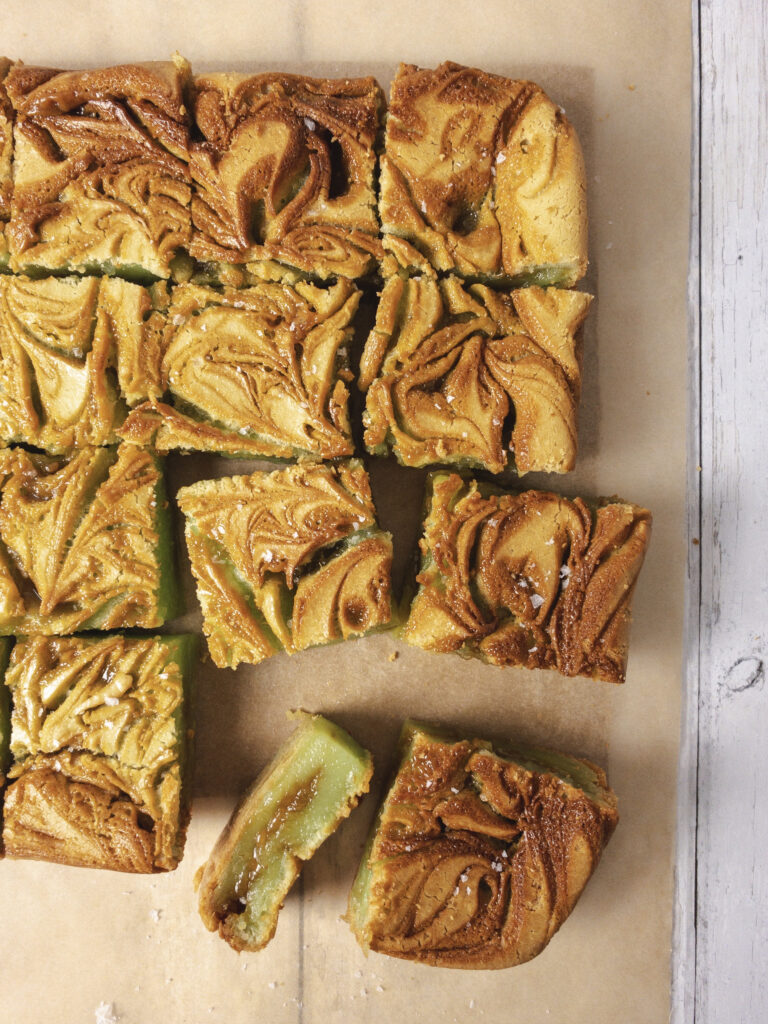
Hawaiian Butter Mochi
A firm favourite in Hawaii, it’s a buttery and chewy coconut dessert that’s often topped with shredded coconut. The centre is wonderfully sticky and chewy, in a way that leaves you confused yet yearning for more. To give it that satisfying chew, Butter Mochi (or any mochi for that matter) is made with glutinous/sweet rice flour which can be found in most Asian supermarkets. I used the ones from Thailand that come in a plastic bag packaging but if you live in the US, I believe the popular choice is Mochiko Sweet Rice Flour. When buying your ingredients, be sure to pick up glutinous rice flour and not rice flour, you will get very different results.
Also, did you know that glutinous rice flour is naturally gluten-free?! I know right, contrary to its name.
What exactly is pandan?
Also known as the “Asian vanilla”, pandan is a tropical plant whose leaves are commonly used to flavour Southeast Asian dishes, desserts and drinks. It has a distinctive, sweet aroma that’s floral like vanilla but with a grassy lilt and notes of coconut. Nothing quite compares to it. You can typically find whole pandan leaves in the refrigerated section of most Asian supermarkets, or at least in the freezer aisle if it’s not available fresh. Alternatively, you can also get them as pastes, extracts and powder – when using these, only a small amount is needed as they are quite potent. These will tint the ingredients with a beautiful green hue so don’t be surprised when you see that happening!
A Singaporean flair, an ondeh-ondeh spin
This recipe is an adaption of Two Red Bowl’s Butterscotch Mochi Bars recipe which truthfully isn’t your traditional Hawaiian Butter Mochi either, but delicious nonetheless. To incorporate the three key elements of ondeh ondeh (coconut, pandan, and gula melaka) into the recipe, I switched out the milk and vegetable oil for coconut milk and coconut oil and added pandan paste into the base mochi recipe. For the butterscotch, I swapped out brown sugar for gula melaka and left out the vanilla extract.

What do I do with leftovers?
Pop these mochi bars into an air-tight container and they’ll stay fresh for 3 days when kept at room temperature. They’ll keep for a week if refrigerated. I recommend heating them up slightly. Warming them in the microwave for 20s (or more, depending on the size of your mochi bars) returns them to their wonderfully sticky chewy state but my favourite way to heat them up is to pan fry them over medium heat. Fry them on all sides in a pan and you’ll get those delightfully crispy edges. Top them off with a drizzle of your leftover coconut butterscotch and you’ve got yourself a banging dessert/snack.
These Pandan Butterscotch Mochi Bars are a Southeast-Asian twist on the incredible Hawaiian Butter Mochi. They are just as chewy, buttery and coconuty as the original version but with the added flavours of butterscotch and fragrant pandan. Inspired by the infamous ondeh ondeh in Singapore, these treats are honestly the stuff of dreams, and couldn’t be any simpler to make! Recipe adapted from Two Red Bowl's Butterscotch Mochi Bars recipe. Preheat the oven to 175°C and line a 8x8 inch square baking dish with parchment paper. To make the coconut butterscotch, melt the butter in a saucepan over medium heat. Add in the gula melaka, double cream and salt and whisk until well combined. Bring it up to a gentle boil and cook for approximately five minutes, whisking occasionally. Remove from the heat and when it has cooled slightly, carefully taste it and adjust the saltiness to your liking. Set aside until ready to use. For the mochi batter, in a mixing bowl, add in the glutinous rice flour, sugar, eggs, coconut milk, coconut oil, pandan paste, baking powder and salt and whisk until thoroughly combined and all the lumps have dissipated. You don’t have to worry about overworking the batter since there isn’t any gluten in glutinous rice flour, and mochi cake is dense to begin with. Pour half the mochi batter into the prepared baking dish. Drop a couple of spoonfuls of the coconut butterscotch evenly across the batter, avoiding the edges if possible so that the butterscotch stays inside the ‘cake’. Pour the remaining batter over the top and add small spoonfuls of the butterscotch across the top. Using a butter knife or a skewer, swirl the sauce evenly throughout the cake (you will have some butterscotch leftover which will keep in the fridge for up to 2 weeks). Gently tap the baking dish on the countertop a couple of times to release any air bubbles. Pop it into the oven and bake for 40-50 minutes or until the edges are puffed and the centre is set. Sprinkle with sea salt flakes and let it cool for at least 30 minutes before slicing into it. It’ll slice much more cleanly when cooled but is phenomenal when enjoyed warm front the oven. Store any leftovers in an air-tight container at room temperature for up to 3 days. Alternatively, keep them refrigerated for up to a week. I recommend heating them before eating - either microwaving it or pan-frying it over medium heat. The latter is my favourite because you get those delightfully crunchy edges, just exquisite. 1. Gula melaka is a type of Malaysian palm sugar made from the coconut palm. It has a delicious toffee, almost caramelised flavour, with hints of coconut. Compared to Thai or Indian palm sugar, its flavour and scent is more concentrated. If you can’t find any of these palm sugars, coconut sugar and brown sugar can be used instead. The main difference between these sugars and gula melaka is that the latter has a more complex and smokier taste, almost resembling molasses but lighter. You can find gula melaka in the dry section of most Asian supermarkets, often shaped into round cylinder blocks. Rather than chopping it, the best way to break it down is to shave it using a sharp knife.
Pandan Butterscotch Mochi Bar
Ingredients
Pandan MochiInstructions
Notes
2. If you have desiccated coconut on hand, I highly recommend sprinkling a generous layer of it it on top as well before baking. It gets all golden and toasty and adds an extra layer of coconut flavour. SO GOOD.

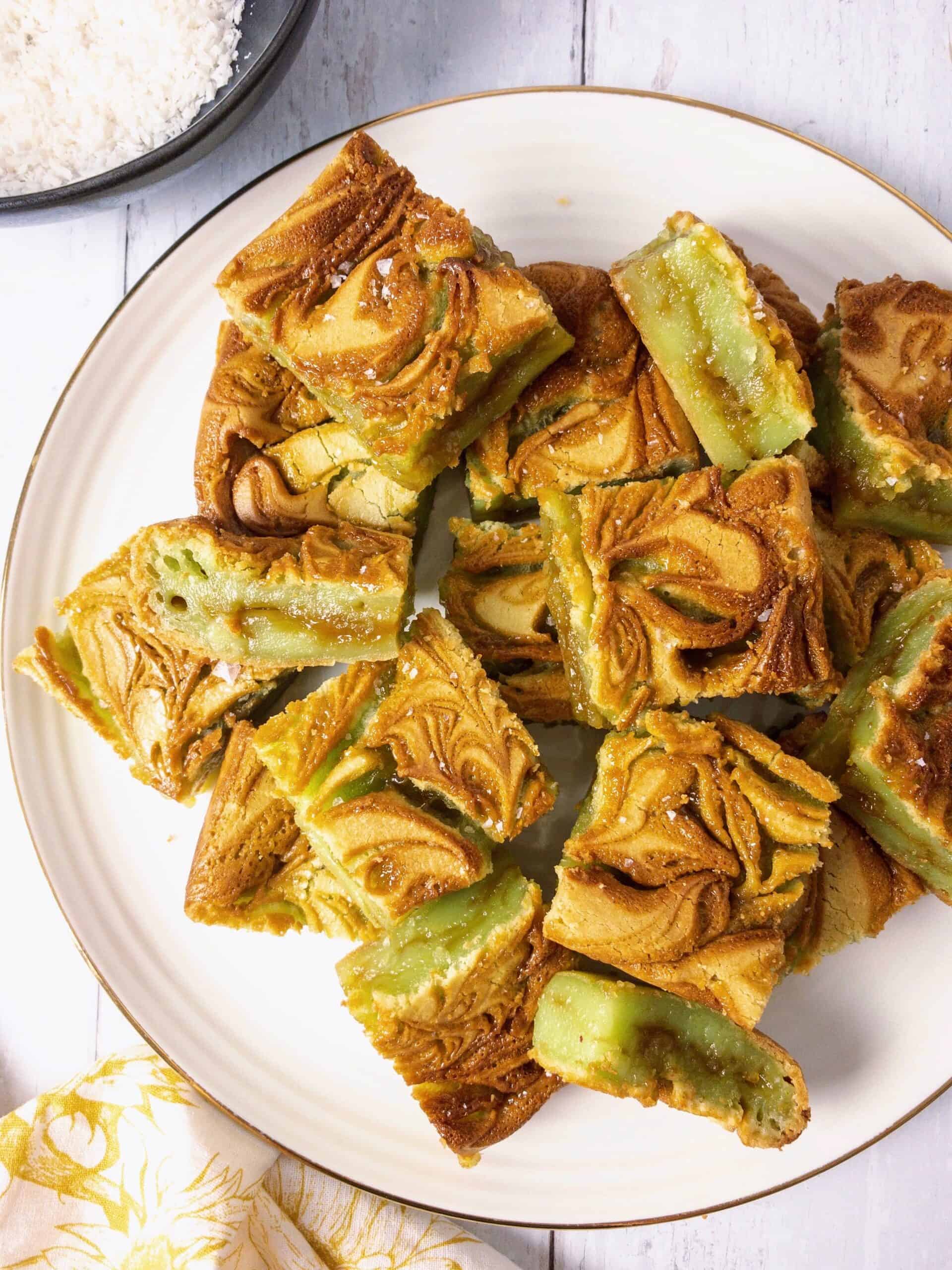


 (6 votes, average: 3.83 out of 5)
(6 votes, average: 3.83 out of 5)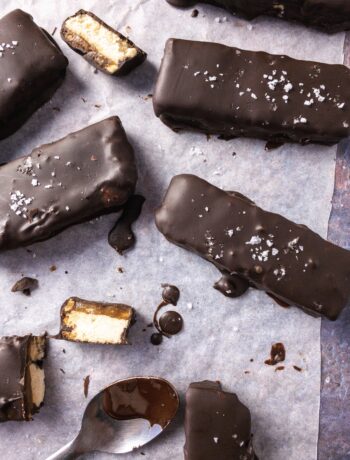
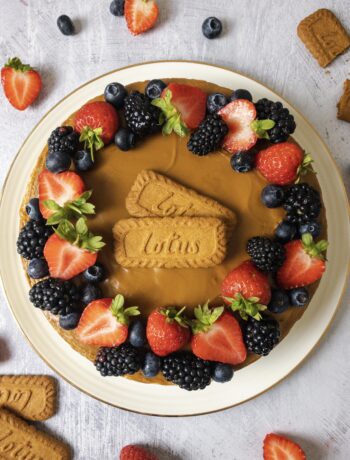
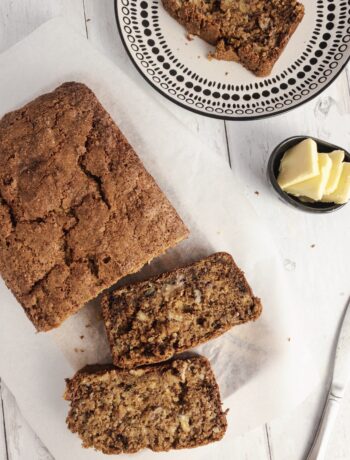
Marisa @ meimeibaking
August 11, 2020 at 12:26 pmWow, these look amazing! I love anything mochi-related or butterscotch-related. I have never had anything flavored pandan, so I’ll have to try it sometime. Looking forward to making this!!
Chyuen
August 21, 2020 at 9:06 amAhhh this recipe would be right up your alley! This is one of my favourite recipes ever so I really recommend giving this a go 🙂
Cherine Chng
January 14, 2021 at 4:58 amhiya! could i use homemade pandan paste for this? I happen to have a pandan plant at home!
Chyuen
March 2, 2021 at 6:13 amYes you most definitely can!
Yvonne Meets Food
March 8, 2021 at 1:08 pmThis recipe is so so good. I ate like five pieces in a single standing session after slicing. The fragrance, the texture, the taste, and the gooeyness of the butterscotch is just TO DIE FOR. I cannot recommend this recipe to all my friends enough! Thank you so much for sharing this. 🙂 🙂
Chyuen
March 31, 2021 at 7:10 amThank you so much for your kind words Yvonne, I’m really glad you enjoyed it 🙂